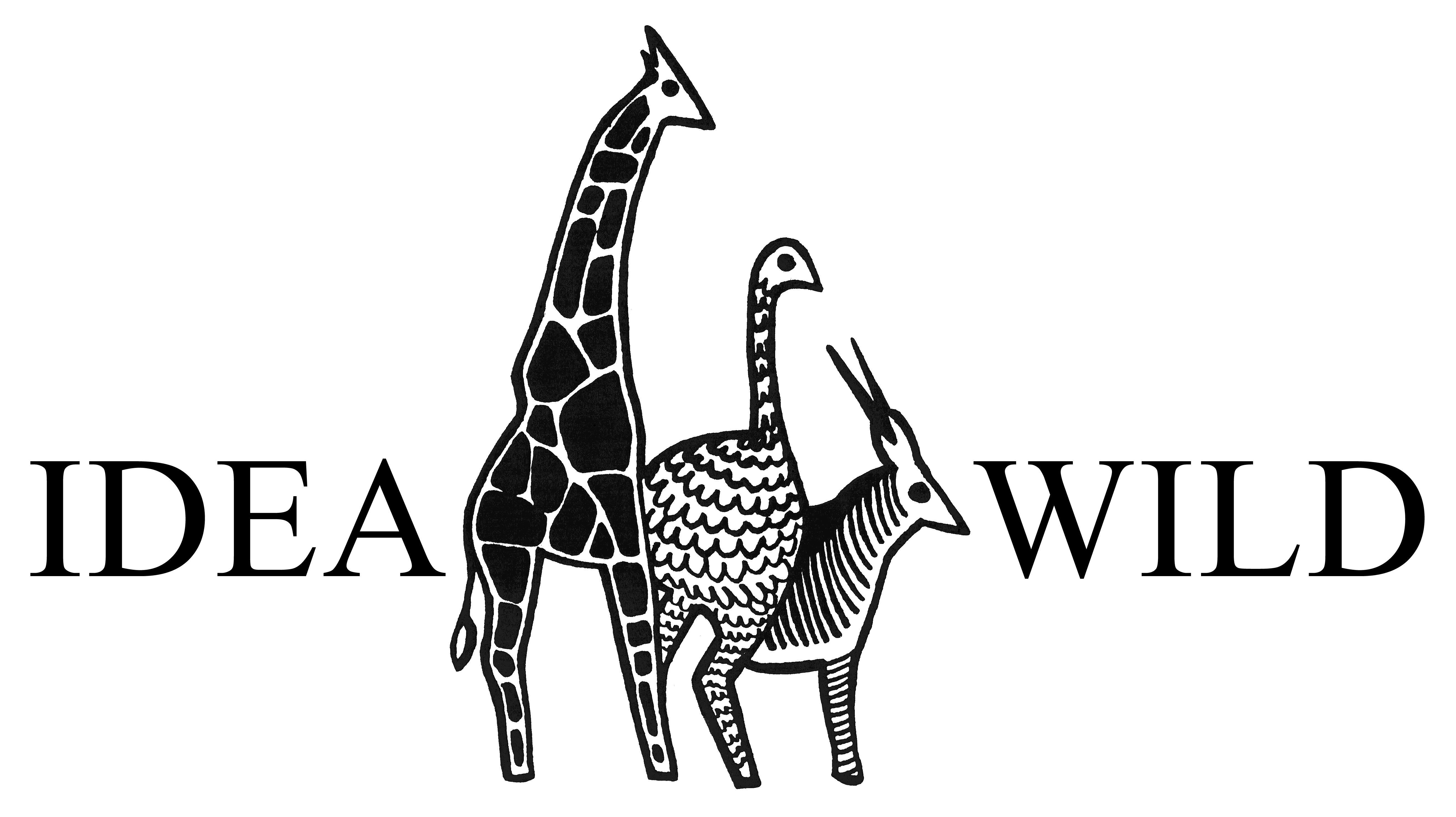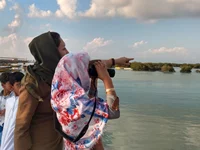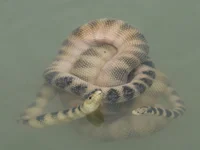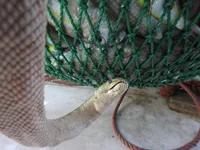Shark and ray conservation in Iran
Duration: 2016 – continuing
Type: Research + Science-based solutions + Education and rising awareness + Direct conservation actions
Taxon: Sharks and rays
QECI's Role: Lead Investigator
Partners:
Sponsors:
Awards:

What is the threat?
Based on official reported catches to the UN Food and Agriculture Organization (FAO), the mean annual chondrichthyan catch in Iran is over 18,000 tonnes (ref). This number does not include all chondrichthyan taxa, as well as fish caught through Illegal, Unreported and Unregulated (IUU) fisheries. Nonetheless, only based on such roughly reported statistics, Iran has been classified among the 26 top chondrichthyan-fishing nations that together are responsible for more than 80% of the total chondrichthyan catches worldwide.
- Rays are extensively caught as bycatch in southern Iran. However, just few of them are landed due to limited commercial value, whereas most are discarded at sea. All above specimens bycaught by trawling boats from southern Iranian waters. Clockwise from up-left: A 50 kg dead female leopard whipray, Himantura leoparda, (IUCN Red-list: Vulnerable); A two meters female shark-ray, Rhina ancylostoma, (IUCN Red-list: Vulnerable); A spotted guitarfish, Rhinobatus punctifer, (IUCN Red-list: Data Deficient) a species endemic to NW Indian Ocean, entangled in a trawling net, but because the fish has no commercial value, fishers did not even bother to remove that from the net; A smoothnose wedgefish, Rhynchobatus laevis, (IUCN Red-list: Vulnerable) one of the few commercially valuable rays landed for its fins, which are highly priced in the shark fin trade .
This problem is exacerbated by the fact that fishing pressures on chondrichthyan stocks in Iran is not a contemporary problem, and has a long history. Only a few decades ago, sawfishes, the most threatened marine fish group, were abundant in the Persian Gulf, but local fishers caught them just for removing their rostrum (the saw) as a decorative object. These amazing batoids have become already extinct in the area, and what remains of them are just soulless rostrums hung on walls, and stories that old fishermen tell about them. An old documentary (Whale Shark Hunting, produced and directed by Hamidreza Ahmadi Laari) also shows that over four decades ago, just by sailing for few hours using a big woody boat (locally known as Lenj), local fishers in Qeshm Island easily caught two adult whale sharks, Rhincodon typus, the largest living fish in our planet, of which each one had a length between 6 to more than 10 meters. Each woody boat came back to the landing site after catching two sharks, not because fishers could not find more, but because the boat couldn’t carry more than two animals. The islanders caught the whale sharks just for taking their livers for producing shark oil. People of the Island can now see these gigantic fishes mostly in the old pictures than in their coastal waters.
- Whiprays and cowtail rays entrapped in an arrow-head fixed fishing trap hanged on the beach to be dried under the sun, fishers then use them as fertilizer. We have heard from some old fishers that in the past when sawfishes were caught, after cutting their rostrum as a decorative object, their meat was also used as fertilizer.
What after being caught?
Sharks and rays are extensively caught by almost all fishing methods that are used in southern coastal waters of the country, from the active fishing methods like purse-seines and bottom/mid-trawls to the passive ones like longlines, gillnets, monofilament nylon-gillnets and fish traps. However, the caught fish have different destinations.
Sharks: Same as in other parts of the world, the fin trade is the main driver for pricing sharks in Iran. An FAO report mentioned that Iranian fishers illegally export dried shark fins to the United Arab Emirates for a price between 4 to 40 USD per kg depending on fin sizes (ref), where the fins are gathered and then re-exported to SE Asian markets. Although not expensive as the fins, shark meat landed by Iranian fisheries is mostly sold in local markets along the southern coastline of the country and used for making some local foods like dried salty shark meat or a local pilaf called Poodeni. However, some shark species, like carpet sharks in the genus Chiloscyllium spp., have no value in the country, not for fins nor for meat. These fish are discarded to the sea after catching.
- Instead of rays, most shark species caught by fishers in Iran are landed, mostly for their fins, but also for the meat. Clockwise from up-left: Neonatal scalloped hammerhead sharks (Sphyrna lewini) in a local fish market at Qeshm Island. If these animals survived, they could grow up to more than 2 m length (IUCN Red-list: Endangered); Sharks caught by a trawling vessel from Iranian waters of the eastern Persian Gulf in just one hour; Headed sharks stored in a fish factory in Qeshm Island; and grey sharpnose (Rhizoprionodon oligolinx) and hardnose (Carcharhinus macloti) sharks are sold by a street vendor in Qeshm Island.
Rays: The situation of rays in Iran seems worse than sharks, because most of rays have no economic value in the country and therefore are discarded to the sea after catching, which cause a lot of post-release mortality. Consequently, instead of sharks that can be found and examined at the landing sites or fish markets, evaluating the batoid fisheries usually need boarding the fishing boats, which is a challenging process.
However, not all rays are priceless in Iran. For example, the wedgefishes in the genus Rhynchobatus spp. are commercially important because their fins contribute to shark fin trade. Ray meat is also used in some areas, like Qeshm Island, to make a local dish named Haleem-e-Pao. Sometimes when lots of inedible rays are incidentally caught by artisanal fishing traps, fishers hang them to dry and then use them as a natural fertilizer.
- Fishers sitting on their boats in the jetty preparing their nets for the next fishing trip have very informative stories to tell about bycaught species. A systematic interview with fishers is a low-cost way that could provide a lot of valuable general fisheries and socio-economic data, however ground truthing by scientific observations is required; Boarding fishing boats allows great opportunities to study bycaught elasmobranchs. There are promising camera monitoring technologies to study bycaught threatened species, but currently direct examination of the specimens can yield much more data.
What did we do to address the threat?
Immediately when we decided to take our first step toward conservation of sharks and rays in Iran, we realized that there is no basic information to show the real magnitude of the problem. There is extensive evidence of sharks and rays everywhere onshore: landed in the ports, stored in fish factories, served in local restaurants, sold by fish markets and street vendors, and even local souvenir shops. There were shown also in many pictures and videos posted by fishers in social media like Instagram. But when we look for solid statistics and scientific information helping us to develop conservation plans, there is but a few case studies.
Therefore, to inform policy and develop on-hand and practicable conservation programs, we started to conduct some basic research aiming to fill these information gaps, which will be followed with holding educational and consulting programs for fishing communities and also testing some bycatch mitigation measures, especially for trawlers.













